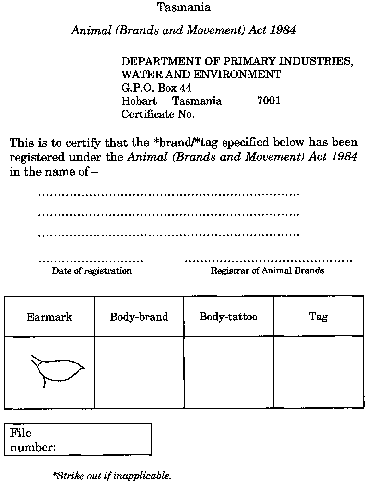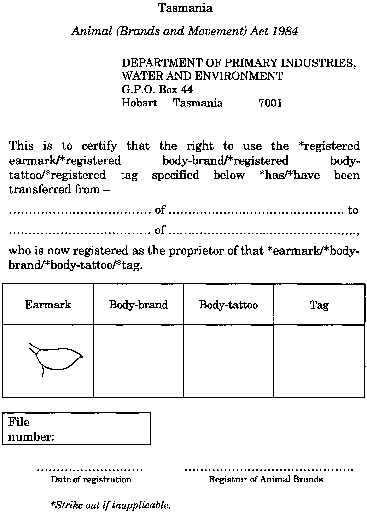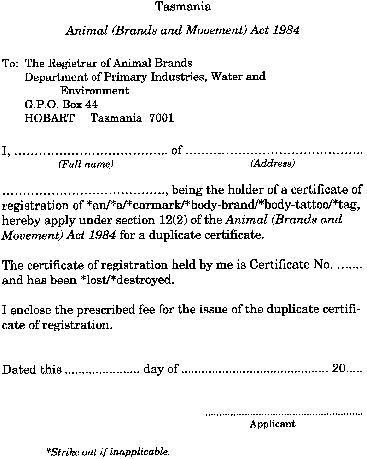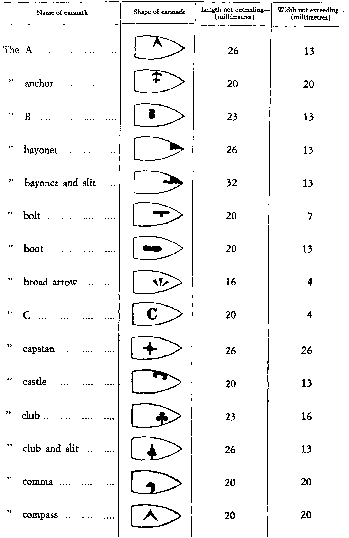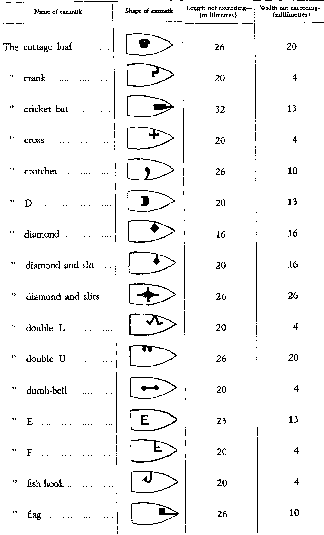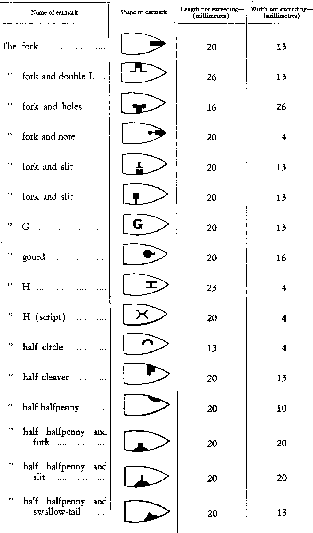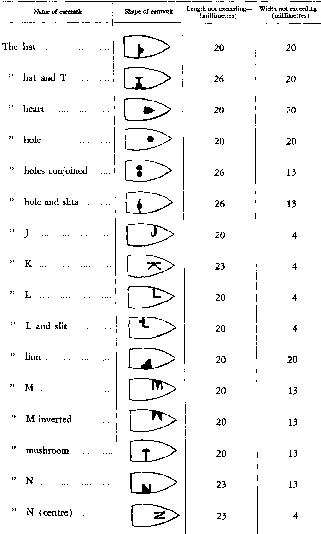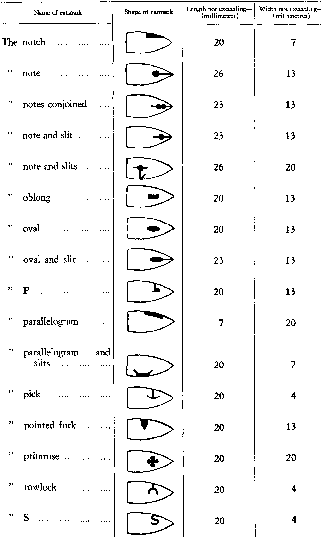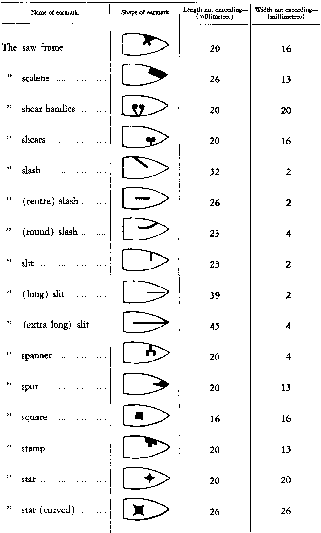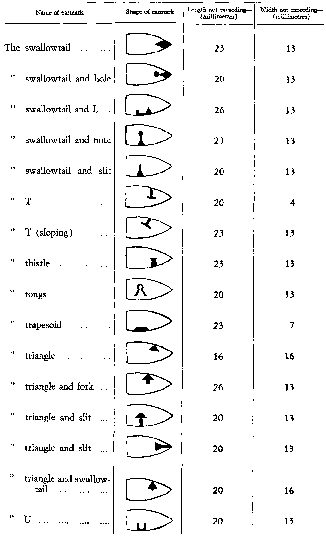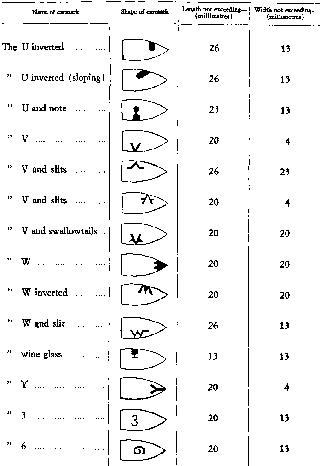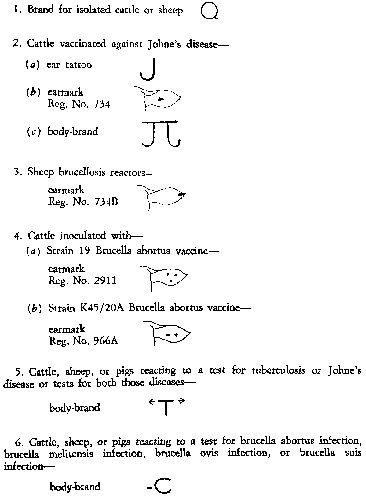Animal (Brands and Movement) Regulations 2003
I, the Lieutenant-Governor in and over the State of Tasmania and its Dependencies in the Commonwealth of Australia, acting with the advice of the Executive Council, make the following regulations under the Animal (Brands and Movement) Act 1984 .
1 December 2003W. J. E. COX
Lieutenant-Governor
By His Excellency's Command,
BRYAN GREEN
Minister for Primary Industries, Water and Environment
PART 1 - PRELIMINARY
These regulations may be cited as the Animal (Brands and Movement) Regulations 2003 .
These regulations take effect on 1 January 2004.
(1) In these regulations, unless the contrary intention appears –Act means the Animal (Brands and Movement) Act 1984 ;approved means approved by the Registrar.(2) In these regulations, a reference to a form by number is a reference to the form so numbered in Schedule 1 .
PART 2 - BRANDS AND TAGS: REGISTRATION AND RELATED MATTERS
4. Form of Animal Brands and Tags Register
For the purposes of section 6(1) of the Act, the register is to be kept in either or both of the following forms:(a) print-outs produced by a computer;(b) documents produced otherwise than by a computer.
5. Cattle and sheep that do not have to be branded with registered earmarks
For the purposes of section 8(2) of the Act, the following classes of sheep and cattle are prescribed:(a) cattle that are registered by a breed society as stud cattle;(b) sheep of which the pedigree for not less than 3 generations is kept by, or is in the possession of, the person in charge of the sheep;(c) ram lambs that are –(i) no more than 12 months of age; and(ii) intended for live export to a country that requires any sheep exported to it not to be branded with an earmark.
(1) For the purposes of section 10(1)(c) of the Act –(a) the pig is to be branded with the registered body-tattoo in a clear and legible manner; and(b) the registered body-tattoo is to be located on the pig's shoulder.(2) For the purposes of sections 10(1)(d) , 11(4) , 11(5) and 21(4) of the Act, the body-tattoo or registered body-tattoo is to consist of no more than 3 letters of the English alphabet –(a) each of which is in an approved typeface and at least 20 millimetres, but no more than 35 millimetres, high; and(b) in an approved combination if there is more than one letter.
7. Nature and dimensions of earmarks for cattle and sheep
For the purposes of sections 11(1) and 18(1)(a) of the Act, the earmark or registered earmark is to be of the nature and dimensions specified in Schedule 2 .
8. Nature and dimensions of body-brands for cattle and sheep
(1) For the purposes of sections 11(2) , 11(3) , 11(5) , 19(1) and 21(4) of the Act, the body-brand or registered body-brand is to –(a) consist, for a cattle body-brand, of a chemical brand, fire-brand, or freeze-brand; and(b) consist, for a sheep body-brand, of a chemical brand or wool-brand; and(c) contain no more than 3 approved letters of the English alphabet or, in the case of a body-brand that is taken to be registered pursuant to clause 5(a) of Schedule 1 to the Act, comply with regulation 55(1) of the former Stock Regulations 1983; and(d) be constructed so that no part of the face of the brand is more than 7 millimetres wide; and(e) be at least 50 millimetres, but no more than 110 millimetres, high (unless it consists of a letter within a sign, in which case the body-brand may be up to 130 millimetres high).(2) In this regulation –chemical brand means a brand that is imposed on the skin of cattle or sheep by means of a depilatory substance on the skin;fire-brand means a body-brand that is intended to be burnt by a branding iron on the hides of cattle;freeze-brand means a body-brand that is imposed on the skin of cattle by means of an implement that has been subjected to a freezing process;wool-brand means a body-brand that is intended to be imprinted or imposed on the wool of sheep.
(1) For the purposes of sections 11(2) and 22(1)(b) of the Act, the tag or registered tag is to be –(a) a tag, of an approved nature and dimensions, consisting of no more than 3 letters of the English alphabet in an approved combination (if any), typeface and size; or(b) an approved electronic or electromagnetic tag; or(c) an approved implant or other device of approved dimensions.(2) For the purposes of section 22(1)(a) of the Act, the registered tag is to be attached somewhere other than the ear that is required to be branded with a registered earmark under section 18(1) of the Act.(3) If the tag or registered tag is of a kind referred to in subregulation (1)(a) , the particulars of identification are, for the purposes of section 22(1)(c) of the Act, the letter or letters mentioned in that subregulation.
10. Brands and tags: application for registration or transfer of rights
(1) An application under section 11 or 13(1) of the Act is to be in an approved form.(2) A single application form may be used for the purposes of section 11 of the Act by the owner of any cattle or sheep who wants to obtain –(a) registration of an earmark for the purposes of section 8(1) of the Act; and(b) registration under section 9(1) or (3) of the Act.(3) A single application form may be used for the purposes of section 13(1) of the Act if the proprietor referred to in that section wishes to transfer more than one right.
11. Fee for application for registration
For the purposes of sections 11(6)(e) and 13(3)(d) of the Act, the prescribed fee is 27 fee units.
(1) For the purposes of section 12(1) of the Act, the certificate of registration is to be in accordance with Form 1.(2) For the purposes of section 13(5)(b) of the Act, the certificate of transfer is to be in accordance with Form 2.
13. Applications for issue of duplicate certificates
For the purposes of section 12(4) of the Act, the application for the duplicate certificate is to be –(a) in accordance with and contain the information required by Form 3; and(b) accompanied by a fee of 9 fee units; and(c) delivered or sent by post to the Registrar.
14. Preparations for branding sheep
For the purposes of section 20 of the Act, the prescribed preparation is a branding fluid containing a scourable dye.
A person must not, for the purpose of branding the ears of any cattle, use, or cause or permit to be used, a branding instrument that is so constructed that it removes more than one third of the ear.Penalty: Fine not exceeding 5 penalty units.
16. Branding for identification to prevent spread of disease, &c.
(1) The Chief Veterinary Officer may require the person in charge of any cattle, sheep or pigs to have them branded in the prescribed manner for the purposes of identification if the Chief Veterinary Officer considers the branding necessary or desirable for the purposes of –(a) preventing the spread of a disease; or(b) facilitating the diagnosis of a disease; or(c) facilitating the conduct of an experiment or investigation.(2) The requirement may be made orally or in writing.(3) A person who is required under subregulation (1) to have any cattle, sheep or pigs branded must comply with that requirement –(a) within such time as the Chief Veterinary Officer specifies when making the requirement; or(b) if no time is specified by the Chief Veterinary Officer, as soon as practicable after the requirement is made.Penalty: Fine not exceeding 5 penalty units.(4) For the purposes of subregulation (1) , the prescribed manner is –(a) if subregulation (1)(a) or (b) applies, a manner directed orally, or in writing, by an inspector; or(b) if subregulation (1)(c) applies, an approved manner.(5) A person who is required under subregulation (1) to have any cattle, sheep or pigs branded must, in complying with that requirement, ensure that the design of the brand applied to the cattle, sheep or pigs is –(a) in accordance with –(i) the appropriate design (if any) specified in Schedule 3 ; or(ii) the appropriate design registered in the name of the Department; and(b) if the requirement pertains to cattle or sheep, located on the left ear of a female and on the right ear of a male.Penalty: Fine not exceeding 5 penalty units.
17. Tagging cattle for slaughter or sale
(1) Subject to subregulations (2) and (3) , a person in charge of any cattle must ensure that they are each tagged for identification with the prescribed tag before they are taken, from the property where they are normally kept, to be –(a) slaughtered at licensed meat premises, within the meaning of the Meat Hygiene Act 1985 ; or(b) sold at a public saleyard.Penalty: Fine not exceeding 5 penalty units.(2) A person who purchases cattle that have been tagged in accordance with subregulation (1) is not required to retag those cattle under that subregulation for a sale or slaughter that occurs within 7 days of the date of that purchase.(3) If a person who is required to tag cattle under subregulation (1) –he or she may have the cattle tagged with an emergency tag.(a) is genuinely unable to tag the cattle with the prescribed tag; and(b) has, through providing the Registrar with an approved declaration for the purposes of this subregulation, obtained an emergency tag –(4) The Registrar is to keep a record of all emergency tags obtained for the purposes of subregulation (3) .(5) In this regulation –emergency tag means a tag that contains –(a) an approved code that identifies the saleyard or district the cattle are from; and(b) a serial number;prescribed tag means a prescribed tag under Schedule 4 .
18. Return of untagged or improperly tagged cattle
(1) If a person fails to comply with regulation 17(1) in respect of any cattle, an inspector may direct the person to return the cattle to the property where they were last normally kept, either immediately or within such time as the inspector specifies.(2) The direction may be given orally or in writing.(3) A person must comply with a direction under subregulation (1) .Penalty: Fine not exceeding 5 penalty units.
PART 3 - MOVEMENT OF PIGS
For the purposes of section 27 of the Act, a waybill is to be in an approved form.
20. Exemptions from making out waybills
The Chief Veterinary Officer may exempt a person from having to comply with section 27(1) or (2) of the Act, either generally or in a particular case, if the Chief Veterinary Officer is satisfied on reasonable grounds that it is not necessary for the person to so comply.
PART 4 - MISCELLANEOUS
(1) An appeal under section 22C of the Act is to be instituted by a notice of appeal lodged with the clerk of petty sessions.(2) The notice of appeal is to specify the parties to the appeal and the grounds giving rise to the appeal.(3) On lodgment of the notice of appeal, the clerk of petty sessions is to –(a) cause a copy of the notice to be provided to the Minister; and(b) notify the parties to the appeal, in writing, of the time and place at which the appeal is to be heard.(4) The magistrate hearing the appeal or a party to the appeal may summon a person to appear and give evidence at the hearing of the appeal by causing that person to be served with a summons.(5) The magistrate hearing the appeal –(a) may adjourn the hearing from time to time or place to place as the magistrate considers appropriate; and(b) may inform himself or herself on any relevant matters in such manner as he or she considers appropriate; and(c) must proceed without undue formality; and(d) is not bound by the rules of evidence.(6) The hearing of the appeal is to be open to the public.(7) A party to the appeal may be represented at the hearing of the appeal by another person (whether a legal practitioner or otherwise).
22. Infringement notice offences
For the purposes of section 29A(1) of the Act –(a) an offence against a provision of the Act or these regulations specified in column 2 of the table in Schedule 5 is a prescribed offence; and(b) the penalty specified in column 4 of that Schedule opposite that provision is the penalty applicable to that offence.
SCHEDULE 1 - FORMS
Form 1 - CERTIFICATE OF REGISTRATION
Form 2 - CERTIFICATE OF TRANSFER OF RIGHT TO USE REGISTERED BRAND OR REGISTERED TAG
Form 3 - APPLICATION FOR ISSUE OF DUPLICATE CERTIFICATE OF REGISTRATION OF BRAND OR TAG
SCHEDULE 2 - Nature and dimensions of earmarks for cattle and sheep
SCHEDULE 3 - Designs of brands for cattle, sheep or pigs
SCHEDULE 4 - Tagging cattle for slaughter or sale
1. Prescribed tagsFor the purposes of regulation 17 , the prescribed tag for cattle of a kind specified in any item of the following table is a tag that –(a) is of the kind specified, in respect of those cattle, in column 3 of the table; and(b) complies with the special requirements specified, in respect of that kind of tag, in column 4 of the table.
Column 1
Item
Column 2
Kind of cattle
Column 3
Kind of tag
Column 4
Special requirements
1.
Calves under 6 weeks old that are –
One of the following tags:
The white plastic ear tag must show the property identification code for the property where the cattle were last normally kept.
(a) unaccompanied by their dam; and
(a) A white plastic ear tag approximately 75mm long and 11mm wide;
(b) being sent –
(b) A permanent identification device approved under the NLIS for cattle
(i) directly to a licensed meat premises; or
(ii) directly to a public saleyard for the purposes of sale and immediate transfer to a licensed meat premises
2.
Mature bulls, other than those identified with a permanent identification device approved under the NLIS for cattle, that are sent directly to a licensed meat premises for slaughter
One of the following transaction tags:
The transaction tag must show the property identification code for the property where the cattle were last normally kept and –
(a) a self-adhesive wrap-around tail tag at least 195mm long and 25mm wide;
(a) if the cattle have been or may have been treated with hormonal growth promotants, be yellow in colour; or
(b) a plastic ratchet tail tag at least 25mm wide;
(b) if the cattle have not been treated with hormonal growth promotants, be pink in colour and be marked "HGP-free".
(c ) a plastic ear tag at least 57mm long and 40mm wide
3.
Any other cattle
(a) A permanent identification device approved under the NLIS; and
(b) if the cattle have been treated with hormonal growth promotants, or it is not known whether or not the cattle have been so treated, one of the following transaction tags:
The transaction tag must be yellow in colour and show the property identification code for the property where the cattle were last normally kept and –
(i) a self-adhesive wrap-around tail tag at least 195mm long and 25mm wide;
(ii) a plastic ratchet tail tag at least 25mm wide;
(iii) a plastic ear tag at least 57mm long and 40mm wide
2. InterpretationIn this Schedule –AQIS means the Australian Quarantine and Inspection Service;European Union Cattle Accreditation Scheme means the accreditation scheme of that name administered by AQIS;EU-listed abattoir means an abattoir approved by AQIS to process meat for the European Union market;hormonal growth promotants means a veterinary chemical product containing a substance that is, or a mixture of substances that are, responsible for oestrogenic, androgenic or gestagenic activity to enhance growth or production in bovines or bubalines;licensed meat premises means licensed meat premises, within the meaning of the Meat Hygiene Act 1985 ;property identification code means a unique code issued by the Registrar to identify a property.
SCHEDULE 5 - Infringement notice offences
Column 1 | Column 2 Section/ Regulation | Column 3 General description of offence | Column 4 Penalty units | 1. | Failing to brand cattle or sheep with a registered earmark before they have attained the age of 6 months | 0.5 | 2. | Failing to brand pigs with a registered body-tattoo within 7 days before selling them or sending them to be slaughtered | 0.5 | 3. | Sections 11(13) , (14) or (15) | Failing to apply for registration of earmark, body-tattoo or body-brand | 0.5 | 4. | Failing to immediately notify Registrar that there is no further requirement for use of registered brand or tag | 0.5 | 5. | Knowingly giving evidence or making a statement that is false or misleading | 0.5 | 6. | Branding cattle or sheep with a registered earmark that – | 0.5 | (a) does not comply with the required nature and dimensions; and | (b) is branded in the wrong place | 7. | Branding the prescribed ear of cattle or sheep with an earmark other than the registered earmark of which their owner is the proprietor | 0.5 | 8. | Failing to mark the ear of cattle or sheep as prescribed | 0.5 | 9. | Branding cattle or sheep with a registered body-brand that is not of the prescribed nature and dimensions | 0.5 | 10. | Person branding sheep with a preparation not prescribed | 0.5 | 11. | Butcher branding sheep with a preparation not prescribed | 0.5 | 12. | Failure by keeper to brand impounded cattle, sheep or pigs before delivery to purchaser | 0.5 | 13. | Failing to attach registered tag to cattle as prescribed | 0.5 | 14. | Obstructing, hindering, delaying, threatening or assaulting an inspector | 0.5 | 15. | Failing to comply with a request of, or answer questions asked by, an inspector | 0.5 | 16. | Failing to comply with requirements relating to waybills | 0.5 | 17. | Failing to comply with the prescribed requirements after receiving a mustering notice | 0.5 | 18. | Failing to tag cattle for identification purposes in the prescribed manner | 0.5 |
Displayed and numbered in accordance with the Rules Publication Act 1953.
Notified in the Gazette on 10 December 2003
These regulations are administered in the Department of Primary Industries, Water and Environment.
EXPLANATORY NOTE
(This note is not part of the regulation)
These regulations prescribe a range of matters for the purposes of the Animal (Brands and Movement) Act 1984; they replace the Animal (Brands and Movement) Regulations 1986.

